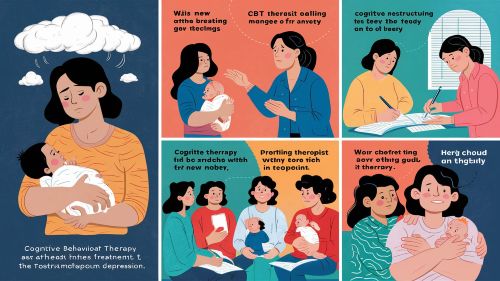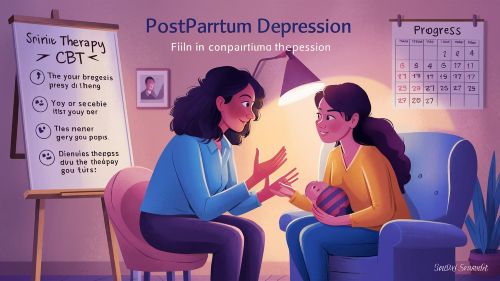When you’re drowning in the fog of postpartum depression (PPD), the word “therapy” can feel both like a beacon of hope and a vague, intimidating concept. You know you need help, but what does that help actually look like? What happens behind the closed door of a therapist’s office or on the other side of a telehealth screen?
The truth is, “psychotherapy” isn’t a single, one-size-fits-all solution. It’s a broad term for a collection of powerful, evidence-based tools and approaches designed to help you heal. Finding the right kind of therapy is like finding the right key for a very specific, very stubborn lock.
This guide is your map. We will walk you through the most effective and widely used psychotherapy approaches for postpartum depression relief. By understanding how each one works, you can become an active, informed participant in your own recovery and choose the path that feels right for you.
Why Therapy? More Than Just Talking
Before we dive into the different types, let’s establish why psychotherapy is a cornerstone of PPD treatment. It’s far more than just venting (though a safe space to vent is invaluable).
Effective therapy for PPD provides:
- Validation: A trained professional confirms that what you’re experiencing is a real medical illness, not a personal failing. This alone can lift an immense weight of shame.
- Skills: It equips you with practical, lifelong tools to manage your thoughts, regulate your emotions, and change your behaviors.
- A Safe Relationship: It offers a confidential, non-judgmental relationship where you can explore your deepest fears and feelings without worrying about burdening a loved one.
- A Path Forward: A good therapist co-creates a roadmap for recovery with you, setting achievable goals and tracking progress.
With that foundation, let’s explore the primary therapeutic “keys” available to unlock the grip of PPD.
1. Cognitive-Behavioral Therapy (CBT): The Practical Toolkit
Best for: The mom who feels trapped in a cycle of negative thoughts and wants practical, step-by-step strategies to feel better.
CBT is one of the most researched and effective therapies for depression. It operates on a simple premise: our thoughts, feelings, and behaviors are interconnected. By changing distorted thoughts and unhelpful behaviors, we can change our feelings.
- The “Cognitive” Part: A CBT therapist helps you become a detective of your own mind. You learn to identify the Automatic Negative Thoughts (ANTs) that PPD produces—thoughts like, “I’m failing at this” or “My baby would be better off without me.” You then learn to challenge these thoughts with evidence, check them for “thinking traps” (like all-or-nothing thinking), and replace them with more balanced and realistic alternatives. [Link to your in-depth CBT article].
- The “Behavioral” Part: This component, called Behavioral Activation, directly fights the inertia of depression. The principle is “action precedes motivation.” You and your therapist will schedule small, achievable, positive activities into your day (e.g., a 5-minute walk, listening to one song, taking a shower) to create an upward spiral of accomplishment and improved mood.
What it feels like: CBT is structured, goal-oriented, and educational. It feels like you’re learning a new skill set. You’ll likely have “homework,” such as thought records or activity logs.

2. Interpersonal Therapy (IPT): The Relationship Healer
Best for: The mom whose depression feels deeply connected to relationship changes, loss, or conflict since the baby’s arrival.
IPT is another gold-standard treatment for PPD. It posits that depression is often intertwined with our social environment and relationships. The transition to motherhood is one of the biggest interpersonal upheavals a person can experience.
IPT focuses on helping you navigate challenges in one of four key areas:
- Grief and Loss: This could be grieving the loss of your old identity, your career, your freedom, or the birth experience you had hoped for.
- Role Transitions: The shift from individual/partner to “mother” is a monumental change. IPT helps you process this new identity and adjust to its demands.
- Interpersonal Disputes: Conflict with a partner, parent, or friend is common postpartum. Your needs have changed, expectations are high, and sleep is low. IPT provides strategies for communicating needs and resolving conflict.
- Interpersonal Deficits: For mothers who feel isolated or have difficulty forming supportive relationships, IPT can help build the social skills and confidence needed to create a “village.”
What it feels like: IPT is focused and time-limited (usually 12-16 weeks). It feels like you’re untangling the specific relationship knots that are pulling you down, with a clear focus on the “here and now.”
3. Dialectical Behavior Therapy (DBT): The Emotional Regulation Masterclass
Best for: The mom who feels completely overwhelmed by intense, out-of-control emotions, including anxiety, panic, or postpartum rage.
DBT was originally developed for borderline personality disorder, but its skills-based modules are incredibly effective for anyone struggling with intense emotional dysregulation, which is a common feature of PPD. The core idea is “dialectic”—balancing acceptance of your current state with the need for change.
DBT teaches four key skill sets:
- Mindfulness: Learning to stay grounded in the present moment without judgment. This is a powerful antidote to anxious “what-if” thoughts or depressive rumination about the past.
- Distress Tolerance: Practical skills to survive crisis moments without making things worse. This can be invaluable for managing panic attacks or intense waves of rage.
- Emotion Regulation: Understanding your emotions, reducing your vulnerability to negative ones, and increasing positive emotional experiences.
- Interpersonal Effectiveness: Learning how to assert your needs, say no, and maintain self-respect in relationships—all crucial skills for a new mom.
What it feels like: DBT is highly structured and educational, often taught in a group setting alongside individual therapy. It feels like you’re going to a class to learn concrete emotional survival skills.
4. Psychodynamic Therapy: The Deeper Dive
Best for: The mom who feels that her PPD is connected to past experiences, unresolved childhood issues, or her relationship with her own mother.
Psychodynamic therapy is what many people picture when they think of traditional therapy. It’s a less-structured, more exploratory approach that aims to bring unconscious thoughts and patterns into conscious awareness.
The idea is that our past profoundly shapes our present. A difficult relationship with your own mother, past trauma, or ingrained patterns of perfectionism can all be triggered by the vulnerability of new motherhood. By exploring these roots in the context of a safe therapeutic relationship, you can understand why you are reacting the way you are and begin to heal those older wounds.
What it feels like: This therapy is often longer-term and less goal-oriented than CBT or IPT. It’s a deep, exploratory conversation focused on insight and self-understanding. The relationship with the therapist is a central tool for healing.
5. Support Groups: The Power of “Me Too”
Best for: Every mom. This should be an adjunct to any individual therapy.
While not a formal one-on-one psychotherapy, professionally-led or peer-led support groups are a powerful therapeutic tool. The isolation of PPD is one of its most toxic symptoms. Support groups shatter that isolation.
Key Takeaway: In a support group, you get to hear the words you’ve been most desperate to hear: “Me too.” Suddenly, you are not the only one feeling this way. The shame begins to dissolve in the light of shared experience.
Groups provide validation, practical tips, and a community of women who are walking the same path. Postpartum Support International (PSI) offers countless free, virtual support groups for a wide range of needs.

Which Therapy Approach is Right for Me? A Quick-Start Guide
| Therapy Type | Best For You If… | What It Feels Like |
|---|---|---|
| CBT | You’re plagued by negative self-talk and feel paralyzed by inaction. You want a practical, structured, “how-to” approach. | A skills-building workshop for your brain. |
| IPT | Your depression feels tied to conflict with your partner, sadness over your lost identity, or loneliness. | A focused, strategic conversation about your relationships. |
| DBT | Your emotions feel huge and out of control. You struggle with intense anger, anxiety, or panic. | An emotional regulation and crisis survival masterclass. |
| Psychodynamic | You suspect your past or your own upbringing is playing a big role in your current struggles and want to understand the “why.” | A deep, exploratory journey into your inner world. |
| Support Groups | You feel deeply alone in your experience and crave connection with other mothers who understand. | A warm, welcoming circle where you can finally say “me too.” |
[Use the WordPress “Table” block for this crucial, user-friendly section.]
Frequently Asked Questions (FAQ)
Q1: How do I find a therapist who specializes in postpartum depression?
Start with trusted directories. Postpartum Support International (PSI) has an online directory of perinatal mental health specialists. The Psychology Today website also has a robust search filter. When you reach out, ask them directly: “Do you have specialized training and experience in treating PPD?”
Q2: What’s more important: the type of therapy or the therapist?
Decades of research have shown that the single greatest predictor of successful therapy is the therapeutic alliance—the quality of the relationship between you and your therapist. You must feel safe, respected, and understood. It’s perfectly okay to “shop around” and have consultations with a few therapists to find a good fit.
Q3: Is therapy enough, or do I need medication too?
This depends on the severity of your PPD. For mild to moderate cases, therapy alone can be very effective. For moderate to severe PPD, the gold-standard approach is often a combination of therapy and medication. Medication can help stabilize your brain chemistry, lifting the fog enough for you to fully engage in and benefit from the skills you’re learning in therapy.
Q4: How can I possibly do therapy with a new baby?
In recent years, telehealth has been a game-changer. Virtual therapy sessions from your own home eliminate the barriers of travel and childcare. Many therapists are also highly flexible and understanding if a baby needs to be fed or held during a session.
Your Lifeline Is Waiting
Choosing to start therapy is a profound act of courage and self-care. It’s an investment in your well-being and in the well-being of your family. You do not have to navigate the stormy waters of postpartum depression alone.
Whether you need the practical tools of CBT, the relationship focus of IPT, the emotional skills of DBT, or the deep understanding of psychodynamic work, there is a therapeutic key that can fit your lock. Your lifeline is out there. All you have to do is reach for it.
Disclaimer: This article is for informational purposes only and does not constitute medical advice. A diagnosis and treatment plan should only be made by a qualified healthcare or mental health professional. If you are in crisis, please call 911 or a crisis hotline immediately.
